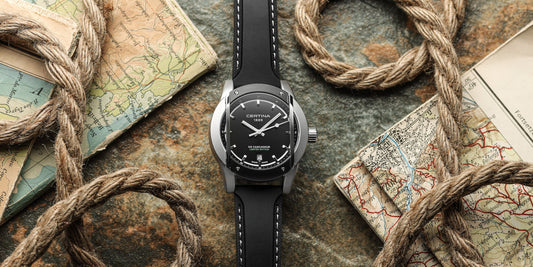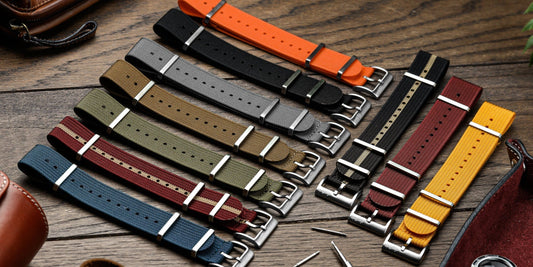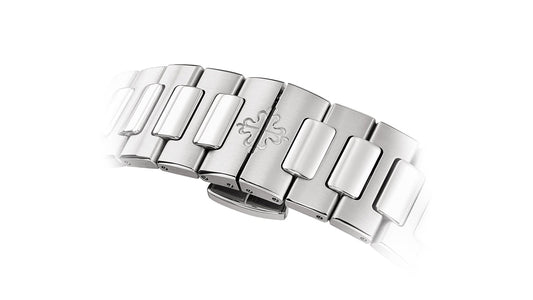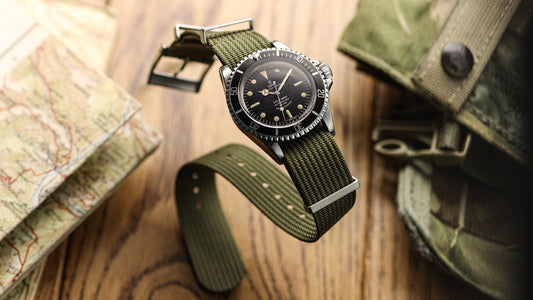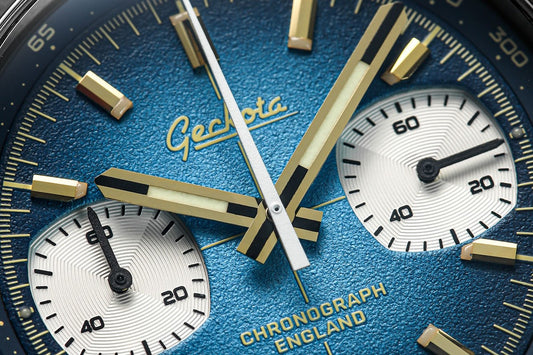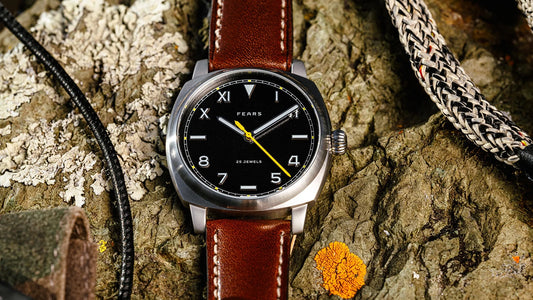The WatchGecko take on diving watches in military, commercial and leisure diving. From Omega Marine to Ressence, read on to find out more...
If there are two watch types that have come from such strong functional backgrounds, and worked their way so completely into the visual language and culture of timepieces, surely it’s pilots’ and divers’ watches. Not long ago, we looked at how 1930s and 1940s aviation influenced many of today’s most coveted timepieces. Now we head underwater to explore the role of diving watches since the 1930s…

Other books and websites cover divers’ watches more exhaustively than we ever could, so we’re not going to try. Instead, what we thought you’d find more interesting is our take on some of the important milestones in the story of the (mainly mechanical) ‘diver’. And references to related resources, which will give you valuable context to the use of diving watches. Among these are a few internet gems – resources that we enjoyed reading and hope you’ll find interesting too.
As one online-forum poster commented, the history of divers’ watches seems ‘ridiculously short’ compared to the long history of diving. The article also highlights how much has happened in a few decades, both underwater and in watch factories. Let’s explore below the surface… Our story really begins in the mid-1920s, with the introduction of Rolex’s ‘Oyster’ case, which combined a water-resistant case with Perregaux and Perret’s patented screw-down crown. There had, of course, been earlier attempts to protect watch mechanisms with inefficient combinations of oils, sealants and crown caps. But nothing like the elegant water-resistant watches that evolved from military necessity before and during WW2.
Probably the most famous of these was the 30 m capability watch that came out of Officine Panerai (‘Panerai Workshops’) in 1936. With it, ‘water-resistant’ watches had evolved into the first truly functional divers’ watches. They’d soon be the first to see serious active service too.
Alexandria 1941
Now jump forwards and imagine being in the heavily defended harbour at Alexandria, Egypt, early on 19 December 1941. Within minutes, in a series of explosions, two British battleships, HMS Queen Elizabeth and HMS Valiant were badly damaged. So were the destroyer HMS Jervis and the Norwegian tanker Sagona. The audacious perpetrators were two-man human torpedo crews of Italian Gamma combat swimmers. They were the ‘torpedo men’ of Italy’s elite Decima Flottiglia Mezzi d'Assalto (aka ‘La Decima’, ‘Xª MAS’ or ‘X Flotmas’, the Italian for ‘10th Assault Vehicle Flotilla’). Their vessels were SLCs (Siluri a Lenta Corsa, or ‘slow-running torpedoes’). Because of their handling characteristics, the crews called them ‘Maiali’ (‘pigs’)!
If any of the Italian frogmen had escaped, and the Italians had realised that the two battleships were disabled, the attack could have changed the course of the war. Why? Because the threat of the two warships deterred the Italians from invading North Africa. As it was, secrecy was maintained and the threat of British naval supremacy in Mare Nostrum (Italian for ‘our sea’) dissuaded Italy from what could have been a game-changing assault on the Allies in Northern Africa.
Along with other raids, several on Gibralter, by Italian combat swimmers, the Alexandria attack was enabled by recently-developed rebreathing apparatus – ironically, British designs made under licence in Italy. And waterproof explosives timers and depth gauges from Panerai. And of course, Panerai’s water-resistant military divers’ watches – reputedly with ‘Radiomir’ lume so bright that divers muddied them to make them less visible to sentries on target vessels.

History was being made
In The Real X-Men: The Heroic Story of the Underwater War 1942–1945, Robert Lyman quotes one of the (by then captured) Italian divers, Vincenzo Martellota:
My waterproof watch was on the table with the other articles taken possession of and I never took my eyes off it. Shortly after 5.54 a.m., a violent explosion was heard, which shook the whole building.
With such daring escapades, horological as well as wartime history was written and the face of amphibious warfare was changing forever. Almost certainly, Martellota’s watch was Panerai’s Radiomir 3646, the result of collaboration between Panerai, Rolex and the Italian Navy. It was collaboration that came just as Italian influence was growing in the new discipline of elite tactical warfare and amphibious special forces. Later, the German military used the Panerai too; they called it the Kampfschwimmer.

The Allies’ response
In response to attacks such as the one at Alexandria, the British examined the mission-enabling Panerai worn by captured Gamma swimmers. There was also the threat of Norwegian-based German pocket-battleships to address.
That was when, spurred on by the following words from Churchill to his chiefs of staff, the Admiralty Experimental Diving Unit was formed. And the British started developing teams of ‘frogmen’ and swimmer delivery vehicles (SDVs):
Is there any reason why we should be incapable of the same kind of scientific aggressive action that the Italians have shown? One would have thought we should have been in the lead.
The Italians had their SLCs, Gamma swimmers and Panerai watches. Soon, Britain would have its own swimmers and hardware. However, to use them effectively, whether driving the so-called ‘chariots’ or operating as ship’s diver from miniature X-class submarines, the frogmen needed suitable underwater timepieces.
In the case of Royal Navy frogmen, such as Donald Cameron VC, who attacked German vessels such as Tirpitz, the watches came from long-established English case maker, A T Oliver. The watches had Longines movements. Interestingly, for security, and despite British hallmarking laws, the sterling-silver-cases of the so-called ‘British Panerai’ bore no hallmarks. For lots of context (but no detailed watch references), read Patrick Bishop’s Target Tirpitz and Robert Lyman’s book.
Meanwhile, across the Atlantic, watches such as Elgin’s canteen-cased divers, and the Hamilton Watch Company’s 1943 Khaki Navy ‘Frogman’ watch with its captive screw-on crown cover, were being developed for Naval Combat Demolition Units. They were further interesting examples of waterproof multipurpose timepieces that emerged from WW2 and were the spiritual forebears of the divers’ watches that would appear in future decades.
Post-war growth of sport diving
A new age in watches and specialist amphibious warfare, accelerated by wartime experience and developments in underwater breathing equipment, bought rapid growth of sport and commercial diving.
The post-war ‘killer app’, to use the parlance of today’s Smartwatch generation, was the new open-circuit Aqua-Lung. This equipment was invented in 1942–3 by Jacques-Yves Cousteau and Air Liquide’s Emile Gagnan. Subsequently, it was developed by France’s Groupe de Recherches Sous-marines. Closed-circuit ‘rebreather’ sets may have been well established. But the self-contained underwater breathing device (SCUBA), with its revolutionary on-demand operation, was about to transform diving for ever and underpin the growth of an enduringly popular leisure diving sector. And of course, all those recreational divers would want diving watches…
In 1947, the French Commando Hubert was formed with initial focus on clearing scores of wartime sea mines still littering the French coast. As well as introducing the new Cousteau-Gagnan equipment alongside Oxygers rebreathers, Commando Hubert’s Lieutenant Claude Riffaud is also attributed with developing the first diver’s board. Later evolutions, with their liquid-filled compass, depth gauge and diver’s watch, would become a vital part of combat divers’ equipment.

The defining diver’s accessory?
As an important, maybe the defining, accessory for the glamorous new world of SCUBA, specialist dive watches suddenly entered the horological mainstream. They were soon given widespread exposure by the exploits of Jacques Cousteau and his divers. Cousteau’s role in popularising SCUBA and various watch brands is reflected in his association with manufacturers such as Blancpain, Rolex and IWC. The latter’s current Aquatimer range even includes a Chronograph Edition ‘Expedition Jacques-Yves Cousteau’ Reference 3768, complete with a case-back engraving of Cousteau wearing his signature red beanie hat.
Over the next decades, early-1950s divers’ watches would influence generations of watches. These ranged from ultra-luxury timepieces to everyday sports watches such as our own K3. The effect on the watch scene can be summed up by the paraphrased words of one commentator when describing the long-term effect of the diving watch’s sudden ascendency. It was, he said, like the effect on aviation if everyone could have their own plane!

What constitutes a diver’s watch?
At their simplest, modern ‘divers’ have high levels of water resistance down to anything between 100 and 4000 m. A clear, easily read face is essential, with highly-legible hands (and excellent lume), and a rotating bezel. This is typically calibrated for 60 minutes with five-minute gradations for measuring elapsed time underwater –and a highlighted, more precisely calibrated 0–15 minute quadrant, which may be lumed for extra legibility.
Snag-resistance, is important too, hence the evolution of protective crown guards. Because divers’ watches are often worn over dry- or wet-suits, some type of strap extender is also important. Options include metal bracelets with extending deployment clasps, rubber straps, and Zulu-type straps. There’s also the expanding ‘accordion form’ pioneered on Seiko’s influential Professional Diver 600 m. This much copied design accommodates the extra diameter of a diver’s wrist when wearing a suit, It also adapts to the effect of varying water pressure at depth.
Other complications for ‘divers’
From rotating bezels to special straps, these are the basics defining the form of modern diving watches. Other complications have also found their way onto ‘divers’. These include helium release valves for professional saturation (SAT) diving, internal and button-release bezels (the ‘anti-luxurious’ Omega Ploprof), oil-filled cases, such as those made by Sinn, to give reflection-free underwater legibility, and chronograph functionality with water-resistant pushers. Then there are the watches with built-in depth gauges (e.g. IWC Aquatimer Deep Three, Oris Aquis, Blancpain X Fathoms) and other dive-related technology…
With time, individual characteristics have come to be associated with particular watches and give them their unique character. For instance, there’s the 10 o’clock helium release valve (or ‘helium escape valve’) on Omega’s Seamaster. Or that unmistakable bezel release button on the Ploprof, Panerai’s distinctive half-moon crown protection bridge, and the 6 o’clock Crown Protection System on ZRC’s Grands Fonds that precludes strapping-on the watch unless the crown is screwed down.

ISO 6425 (1996) for Divers’ Watches
It took over 40 years from the halcyon post-war days of diving for an international Standard for divers’ watches to be developed and published. The result was ISO 6425.
In WatchTime magazine’s book, The World of Watches: Dive Watches, the author references Berner’s Illustrated Professional Dictionary of Horology, which defines a ‘diving watch’ as follows:
[A] watch designed to withstand immersion to a depth of at least 100 m and to satisfy requirements specified in ISO Standard 6425.
Reading the (now online) horological dictionary also reveals the following note:
N.B. according to this standard, only the hundreds of metres have to be indicated on the watch. v. water-resistant watch, water resistance.
This very strict definition comes from the heart of the Swiss watchmaking establishment. Interestingly, Japan, which entered the divers’ watch market in 1965 with the Seiko 150M Diver’s, follows JIS B 7023: 1993 (a modified version of ISO 6425).
In practice, relatively few diver’s watches claim compliance with ISO Standard 6425 (1996) or even the less stringent ISO 2281 for water resistance. The ISO 6425 Standard is much less well known, formally adopted or referenced in marketing materials than the COSC’s well-known chronometer standards.
Some manufacturers, such as Omega and Rolex, evidently put more store in having in-house evaluative criteria for their divers’ watches. And maintaining that these are more stringent than ISO 6425. Other manufacturers rely on testing and certification of their watches by other authorities, For example, Sinn Spezialuhren makes much of ‘testing to European diving equipment standards’ and certification by DNV GL (Det Norsk Veritas and Germanischer Lloyd) for its 2016–17 range of T1, U1000, U1, U2 and related dive watches. These, incidentally, are made of high-performance German submarine steel.

Summary of ISO 6425 requirements
Here then, in brief, is what ISO 6425 covers, which generally concerns physical requirements. More details are available in sections 6 and 7 of the Standard. (The detailed content is readily available online, for instance, here.)
- A ‘time pre-selecting device’. This may be a rotating bezel or digital display and must be protected from inadvertent manipulation (hence unidirectional bezels). Any bezel must also have a scale showing 60 minutes with five-minute gradations. The watch’s dial must also be readable, in the dark, at 25 cm. And it must have an indicator to show that the watch is still running.
- Next are requirements governing salt-water resistance. The ISO stipulates that a dive watch must be resistant to 100 m. If this seems strange, remember that non-pro divers won’t dive beyond 35–40 m, the point at which specialised mixed-gas breathing and decompression are required. Add to this underwater reliability, antimagnetic properties (if applicable to a given watch) and shock resistance.
- Lastly, come standards for resistance to external forces, thermal shock, overpressure and (optional) air-tightness at an overpressure.
If a watch conforms to ISO 6425, it may be marked with the word ‘Divers’ followed by a depth rating in metres. However, as mentioned above, many capable diving watches aren’t marked in this way (for a widely available mid-price watch that does, check out Certina’s DS Action watch). Perhaps this is down to an unwillingness to pay, in time and money, for the costs of getting compliance. This seems particularly likely if, like Rolex and Omega, they have high (dare we say ‘supreme’) confidence in their in-house standards.
The classic diver’s watches
When the history of diver’s watches is reviewed, which are truly iconic pieces, the classics that define the subsequent characteristics and visual language of diving, and more generally, sports watches? Search Google and it can seem there are as many ‘top divers’ watches’ articles as there are watches.
The word ‘classic’ gets thrown around more casually than a weekend ‘beater’, so it deserves clarification. To do this, who better than an elder statesmen of American product design, Del Coates, author of Watches Tell More Than Time. In the book, which we’d highly recommend to anyone interested in product design, and which contains numerous watch-related examples, Coates says the following:
Essentially, a classic product departs from norms so much that it no longer fits neatly into any existing class. It consequently requires definition of a new class if it is to be categorized at all – thus the term classic.
Earlier, Coates writes:
We tend to call perennial favourites classics. But this word does not go deeply enough to explain the special appeal of beauty. We revere classics in large part because they are beautiful. Or perhaps their beauty lies below the skin, in which case they are beautiful because they are classics…we have diluted classic until it has lost the special air that once surrounded it. Too often, now, classic just means “old”, “rare” and “expensive”.
With this in mind, let’s look at some undoubted classic watches, the horological icons that define the evolution of divers’ watches from WW2 until today.

Into the pantheon of iconic ‘divers’
Their names include Seamaster, Aquatimer, Submariner, Hydroquest, Grands Fonds (literally, ‘deep’), Fifty Fathoms, Pelagos and Superocean. The watches salty descriptors speak volumes about divers’ (and ‘desk divers’) expectations of their timepieces. With lineage often traceable to early days in underwater exploration, they promise functionality and performance in your swimming pool, at the bottom of Lake Neuchâtel or on the deepest ocean floor. They also inspire homage watches such as ours.
So which diver’s watches, if we apply the foregoing, deserve true classic status? Which are milestones in the evolution of the ‘diver’s watch’ that call, siren-like, from the jeweller’s window, dive shack or online store? Which have shaped and defined our understanding of ‘diver’s watch’?
So much has been written and so many strong opinions are held about ‘bests’. Again, we won’t try to be definitive here. Instead, after researching the topic, here’s our take on some contenders. And the context of their evolution and use (with apologies for any omissions, and no indication of relative importance implied by their order, or how much copy is devoted to each).
For a start, we’re discounting early experiments with ‘waterproofed’ derivatives of ordinary watches. Or the original 1926 Rolex Oyster, which, though water-resistant when famously hung from Mercedes Gleitze’s neck, was never intended for diving.
Omega: the first proper diving watch?
At risk of annoying Rolex fans, there’s a strong argument for giving the honour of ‘first diving watch’ to 1932’s quirky Omega Marine. This had a rectangular, almost Cartieresque face and latching, water-resistant slipcase to circumvent Rolex patents.
The Marine was tested to an impressive 14 m by contemporary explorer Charles William Beebe. In 1939 the original version was followed by the updated Marine Standard. And in 1948, by the first manifestation of the now legendary Omega Seamaster. According to the Omega museum website, this was inspired by Omega wristwatches made for the British military at the end of WW2. The Seamaster was pitched at buyers seeking, ‘a robust yet elegant watch for active individuals who wanted “a watch for town, sea and country.”
Later came the Seamaster Ploprof (plongeur professional: French for ‘professional diver’) and Planet Ocean derivatives with their continued diving, adventure and James Bond associations.

Panerai’s heroes and epic enterprises
As mentioned earlier, on the eve of the Second World War, Panerai, working with the Italian Navy, developed 10 prototype Rolex-powered Panerai Radiomir for Italy’s frogmen.
For some enthusiasts, the original Radiomir is considered the pioneer of mass-produced ‘military’ divers’ watches. Panerai already supported the Italian armed forces with instruments. However, it was the 1936 prototypes, with Staybrite steel cases, welded wire lugs, high-luminosity markings and long water-resistant straps, that kick-started the illustrious horological collaboration between Panerai and Italy’s military. The relationship ultimately spawned, among others, the rare Mare Nostrum deck-officers’ watch, now-signature Luminor case with distinctive crown-protecting bridge, and 60 mm diameter Egiziano made for Egypt’s navy.
Only later, in the 1990s, did Panerai break into the civilian watch scene with three limited edition series: Luminor, Luminor Marina and Mare Nostrum. With them came promotional imagery that still draws on Panerai’s long association with oceans, undersea warfare and the siluri a lenta corsa.
Blancpain’s big claim to fame
Blancpain also has a credible claim to at least one key divers’ watch development. For 1953, at the French Navy’s request, they developed their 50 Fathoms, or ‘FF’. Their claim? That it was the first true ‘100 m’ dive watch and the first watch with a rotating bezel developed specifically for divers. The FF came from close collaboration with military divers of the French Combat Diving Corps, in particular Bob Maloubier and Claude Riffard. As an aside, before being a founder member of France’s equivalent to the US Navy Seals, Maloubier, who later received the MBE and died in 2015, aged 92, was also a distinguished member of Churchill’s WW2 Special Operations Executive (SOE).
The Corps, formed in 1952, had evolved from the first ‘nageurs de combat’ resistance unit formed in Tunisia in 1940 under the 2e Bureau’s Colonel Niel.

As clear as a guiding star…
To understand the timepiece’s required specification, first take the French divers’ requirement for a high-performance, high-visibility diving watch. It had to be a watch with black dial, large Arabic numerals, clear indications and a rotating bezel for easy elapsed time monitoring. Now add the interest in hobby diving of Jean-Jacques Fiechter, who’d just begun 30 years as Blancpain’s CEO. The result is the stuff of horological folklore. And a legendary watch for which another part of Maloubier’s brief was reputedly, ‘…that each of the markers be as clear as a guiding star for a shepherd.’
The Fifty Fathoms is still represented by multiple versions in Blancpain’s range. These sit alongside the exotic 500 Fathoms, X Fathoms and Bathyscape. Over time, the ‘FF’ became dive watch of choice for many special forces teams. These included the combat swimmers and clearance divers of Israel, Spain, the USA and Germany. In the latter case, as recently as 1975, the Bundeswehr commissioned special 3H FF watches for their Kampfschwimmers (the 3H references Hydrogen’s radioactive isotope). Also of note is the absence of numbered bezels on these highly collectable watches. Why? Because the German divers’ use of Dräger rebreathing equipment, and the duration of underwater operations the equipment allowed, didn’t require the 60-minute marking used by sports divers.
The ‘Sub’ surfaces
At the start of the 1950s, Rolex was keen to develop a genuine ‘do anything’ sports watch that would be equally at home underwater or in the executive suite. Led by chief executive René-Paul Jeanneret (another keen diver) the result was the Rolex Submariner – albeit with a bi-directional bezel, but without today’s characteristic crown guards.
Today the ‘Sub’ is recognised as a genuinely iconic fusion of sports and diving watch. The timing of their two product launches in 1953–4 means it’s no surprise that, ever since, Rolex and Blancpain have vied for recognition as creators of the ‘original’ rotating bezel ‘diver’.
From what we can establish, the ‘FF’ was, by the hair on a diver’s forearm, the first true ‘100 m divers’ watch’ to reach the diving community. But with its public launch at Baselworld 1954, the Submariner takes the honours as the first 100 m ‘diver’ to be widely available to the public. Subsequent incorporation of the Rolex into the popular psyche as the luxury divers’ watch reflected the strength of Rolex promotion that continues today.

During research for this article, it occurred to us that Rolex may have justified their claim based on literal, arguably pedantic, but technically correct, conversion of 50 Fathoms as 91.45 m! Whether or not this is true, Rolex and Blancpain both claimed to have invented the modern divers’ watch. Interestingly, this conveniently overlooks the earlier achievements by Omega and Panerai. Ultimately, interpretation comes down to what you believe ‘first divers’ watch’ means. What is indisputable is that, between them, the early ‘FF’ and ‘Sub’ were the pinnacle of early 1950s divers’ watch technology.
Both have since built on their early reputations. Arguably, the Rolex Submariner, Sea-Dweller and Deepsea, have led to Rolex dominating the luxury sports diver space – and a plethora of fakes and homages inspired by the original ‘Sub’.
Notably, Rolex has done this through association with record-breaking deep dives (Walsh and Piccard’s 1960 10,916 m in Trieste and James Camaron’s solo 12,000 m in Deepsea Challenger in 2012). And with Ian Fleming and Sean Connery’s written and cinema James Bond. Another indication of Rolex’s promotional flair, even back in the 1950s comes from Jacques Cousteau. Though reportedly a ‘Blancpain man’ at heart, sometimes wearing Submariners meant that Cousteau was an early ambassador for Rolex – setting the pattern for other celebrity ambassadors who followed.

From outer to inner space
There’s the unique experience of former NASA Mercury astronaut Scott Carpenter too. Carpenter (1925–2013) moved from Brietling allegiance to Rolex when, uniquely, he bridged the gap between pilot-astronaut and divers’ watches – and made the world’s first seabed to outer space call. He achieved this while team leader in the 1960s SEALAB II project, a venture for which Rolex developed the Sea-Dweller. For more information about Carpenter’s inspiring life in outer and inner space, visit Jake’s Rolex World at the Rolex Magazine
Moving from La Jolla Canyon, off California’s coast, to the stormy North Sea, here’s an interesting demonstration of how Rolex successfully combined serious ‘tool watch’ and ‘ultimate bling’. It’s also a reminder of the role divers’ watches play in life-and-death timekeeping for their wearers. This is a quote from former commercial diver David Harrison Beckett’s autobiography. In The Loonliness of a Deep Sea Diver, Beckett describes pro-diving in the North Sea oilfields of the1970s:
If you went down to 170 feet on air, your bottom time was only seven minutes and you would spend roughly that time swimming back up to the surface. Stay down there for 40 minutes and you would take about 75 minutes to reach the surface safely. The accuracy and reliability of your watch was of paramount importance, which is why, certainly back in those days, many divers would be wearing a Rolex. I think they also liked to be a bit flash.
ZRC Grands Fonds – by divers for divers
Conçue par des plongeurs pour des plongeurs (‘designed by divers for divers’) was a contemporary advertising strapline when ZRC’s Grands Fonds 300 appeared. The watch promoted in those monochrome ads evolved from yet another 1950s collaboration. This time, between Lake Annecy’s pro-divers, jeweller Zuccolo Rochet & Cie, and a Toulon watchmaker with close French Navy connections. The resulting alliance led to the first ZRC Grands Fonds 300 for navy divers.
After three years’ service with French mine clearance teams, the navy asked ZRC to redesign the watch. In particular, they wanted better protection for the the vulnerable 3 o’clock crown during underwater operations. What’s more, this had to be achieved without impeding wrist movement. And in such a way that the watch couldn’t be strapped on and submerged with the crown unscrewed.
The general vulnerability to snagging of divers’ watches while underwater is demonstrated by an incident that occurred while clearing a ship’s induction inlet. It is described by former Royal Navy Clearance Diver Mark Holroyd in his book, Frog Tales.
Purely by luck, I managed to locate the inlet, that was only because I got my hand stuck inside it as I struggled to turn over on to my back. Removing my hand was not easy either, because my watch had become stuck, so removing the watch slowly (I would never find it if it dropped), I released my hand. The inlet was completely blocked and even if I cleared it fully, it would soon clog back up again but that would be someone else's problem hopefully.
A legend is born (but Rolex wins at marketing)
Back to ZRC and the revised watch was the now-classic, dare we say legendary, 1964 Grands Fonds 300. The watch had a unique 6 o’clock crown with a proprietary crown protection system (CPS) and retractable connection lug. The latter prevents the watch being worn, and submerged on a diver’s wrist, unless the crown is screwed down.
As well as being the world’s first 100% single-piece case, the Grands Fonds 300 case was machined from – at-the-time-unique – ‘magnesium-reinforced’ steel. This made it completely antimagnetic for mine clearance work. With addition of ultra-luminescent ‘Magnum’ hands, the French Navy had a watch that served them well into the 1970s. It wasn’t just used on ordnance clearance either. The GF 300 also saw service for diver training and use by the elite Hubert Commando special forces and counter-terrorism unit. Not surprisingly, the watch also found its way (along, it seems, with most big-name 1950s–60s ‘divers’) onto the wrists of Jacques Cousteau’s team.
As a coda to the original story, ZRC reissued the GF 300 in 2015. Alongside the original CPS, there’s now a proprietary easy-clean system to keep the gap between case and bezel free of crystallised salt – and an ingenious automatic strap-lengthener.
With the end of the 1950s approaching, Breitling’s monocoque-cased Superocean appeared with its locking bezel and 200 m water resistance. By this time, the sport, exploration and commercial diving boom was unstoppably superimposed on continuing military watch development.
Subsequent development of ‘divers’ has progressed with most brands adding more or less capable ‘diver’s watches’.
Interestingly, with widespread adoption of dive computers in the 1990s came the end of divers’ reliance on watches as primary dive-management tools. Yet, despite this, the popularity and proliferation of dive watches at all price points actually increased. And so did the pace of what WatchTime described as ‘the race to the bottom’ as divers’ watches appeared with ever-higher high water-resistances and more elaborate complications.



